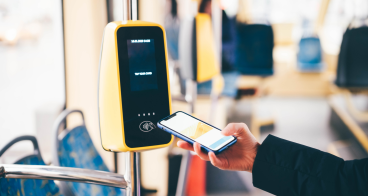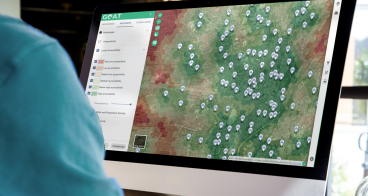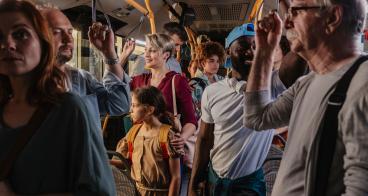“Please mind the gap!”: A comparison of European and American rider experiences
Riders on public transport want the same thing no matter where in the world they are; a reliable, seamless and efficient service that is affordable, accessible and safe for all. This article showcases locations in Europe and the United States that are trying to better understand the needs of riders and increase public transport ridership, with varying levels of success.
For many transit riders, there is nothing worse than getting to a platform or stop and realising that your train or bus is cancelled, and you need to wait until the next one. Unfortunately, this is not an unusual occurrence for many regular riders.
In my nearby city of San Francisco, widely renowned as having one of the best transportation systems in the US, less than half of riders described the reliability of the city’s bus and light rail service as either “good” or “excellent”. The most significant sources of transit delay are related to both street design and transit operations, but surely these issues are possible to overcome with the right fiscal support, resilient infrastructure and coordination between providers. Cities in Europe and the US should take note of the best practice example of Zurich, whom the World Economic Forum in 2022 named the “best public transport provision” in Europe and second in the world, under criteria including infrastructure quality, social impact, market attractiveness, system efficiency and network innovation.
Access for all
If people want to use public transport, they need to be able to access it. Even within cities where amenities are typically conglomerated, accessing a transit link may require other modes. The recent surge in micro-mobility within Europe has bridged this gap. Between the first quarter of 2022 and the first quarter of 2023, ridership of most modes of shared mobility in Europe increased. Dockless bike schemes saw particularly strong growth, with a ridership increase of 25% . In US cities on-demand micro-transit has increased rapidly with small bus shuttles linking people to transit hubs and activity centres. Similarly, paratransit has allowed disabled users the same level of access to amenities where public transport is not possible due to a lack of service coverage or inadequate provision for disabled riders.
The freedom to travel
In February 2020, Luxembourg made its world-class public transport system free to all residents and visitors. This unprecedented move eliminated affordability concerns that can be a barrier for many riders. But in a small country of under 700,000 residents with the highest GDP per capita of any country in the world, Luxembourg’s bold move to introduce free universal public transport did little to reduce what a recent Bloomberg article described as a “car-crazy” culture. Despite this, users of the system have high praise and see it as “a good form of freedom”. In countries that lack Luxembourg’s economic and geographic advantages, a lack of public funding, the absence of stakeholder support and, in some cases, entrenched interest groups that favour private vehicle use, are factors that combine to make provision of free public transportation no more than an aspiration.
In recent years, many US cities have experimented with free transport service provision on a small scale. For instance, some urban areas in California have recently introduced and expanded free shuttle buses and park-and-ride schemes designed to take commuters from parking complexes and train depots to downtown shopping areas and office spaces. US cities have also frequently dabbled with eliminating fares on public transport systems on public holidays. But private vehicle ownership remains by far the most popular form of transport for Americans. Even in cases where public transportation could be used, the ubiquity of the yellow taxi in New York City and rapid expansion of ride-share services such as Uber and Lyft may be taken as evidence that speed, efficiency and privacy are important considerations to Americans. Therefore, in both Europe and the US these examples demonstrate that it takes more than free public transport initiatives to influence a modal shift away from the private vehicle.
See it. Say it. Sorted!
An often-cited barrier to public transportation usage amongst riders are concerns around their personal security. Fears are heightened on public transport from the need to travel in a confined space for periods of time and at station stops that can sometimes be dark and deserted. In my home city of London, the catchphrase that has always stuck in my head from riding the public transport system is “See it. Say it. Sorted!”, which is repeated frequently via public service announcements and is designed to encourage travellers to report any suspicious or unusual activity on the network. Despite the expansion of dedicated transport policing services and security cameras on public transit vehicles and at stops and platforms, public transport is notoriously difficult to police in real time. Therefore, security personnel encourage the public to inform them of incidents occurring so they can respond as quickly as possible.
In the earlier mentioned survey in San Francisco, only 42% of respondents were satisfied with safety and security measures on the city’s public transport network, while a recent survey in Europe found that 19% of public transport users reported cases of harassment. Personal security clearly remains a critical concern for both European and American riders, and in many cases makes private transit a preferred alternative.
To conclude, public transport providers in Europe and the US are trying to address the needs of riders with varying levels of success. Although every city has its own challenges to meet this demand, through greater awareness of best practice examples and knowledge sharing they can get closer to meeting the needs of their riders.
The keynote's author, Lucy Mascarenhas, is a transport planner who has worked and lived in London, Luxembourg and California gaining an understanding of public transport planning and first-hand rider experience in these localities. She specialises in sustainable and emerging mobilities, and her project experience includes re-designing town centres to improve sustainable travel, urban air mobility research and strategic public transport planning. She is a strong believer in stakeholder engagement and collaboration and public outreach to inform the design of our future cities and the communities they serve.
Further reading:
- National Association of City Transportation Officials. Transit Street Design Guide – Reliability Matters. Accessed on 7th October 2023, https://nacto.org/publication/transit-street-design-guide/introduction/why/reliability-matters/
- Acea. Vehicles in Use Europe 2022. Accessed on 7th October 2023, https://www.acea.auto/publication/report-vehicles-in-use-europe-2022/
- Brown, H. (2023) Europe’s richest country made public transport free: Could other countries do the same? Euronews.green. Accessed on 7th October 2023, Europe’s richest country made public transport free: Could other countries do the same? | Euronews
- Via. (2022) Three cities redefining paratransit with new technology, accessed on 7th October 2023, https://ridewithvia.com/resources/articles/three-cities-redefining-paratransit-with-on-demand-technology/
Published on 16 October 2023.






